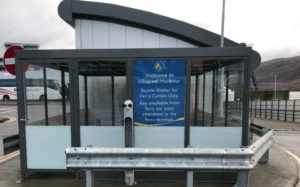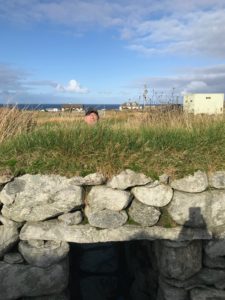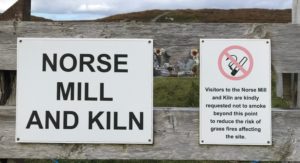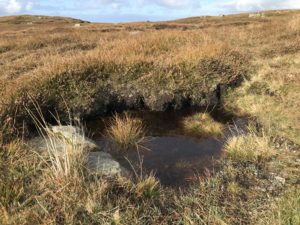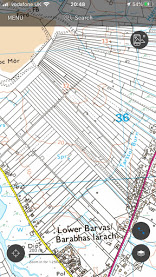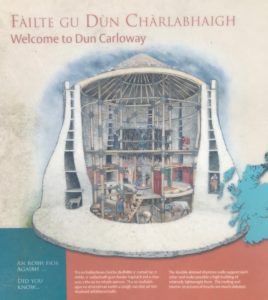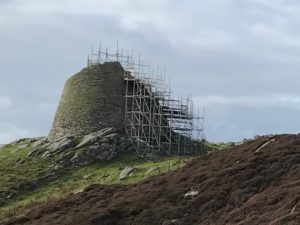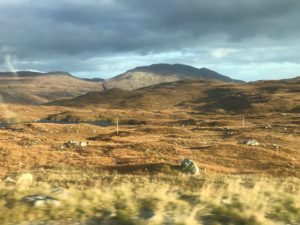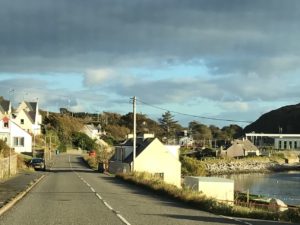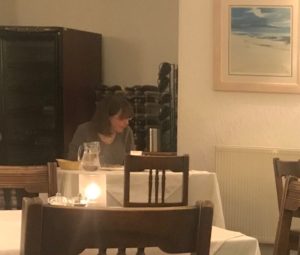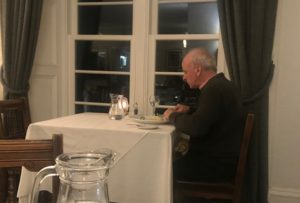In which Sid and Doris go to the Outer Hebrides.
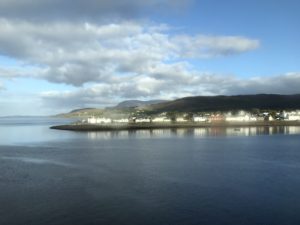 The day starts with Sid and Doris “on the stage” in the Ceilidh at The Ceilidh Place Hotel. Due to you know what there are no ceilidhs so the socially distanced tables are placed on the (single-step) raised stage area too. With much navigator’s twitch we put Teal in the ferry queue far too early and go for a walk by the harbour. It is not raining and you can imagine docking on the harbour wall, then coming in for dinner.
The day starts with Sid and Doris “on the stage” in the Ceilidh at The Ceilidh Place Hotel. Due to you know what there are no ceilidhs so the socially distanced tables are placed on the (single-step) raised stage area too. With much navigator’s twitch we put Teal in the ferry queue far too early and go for a walk by the harbour. It is not raining and you can imagine docking on the harbour wall, then coming in for dinner.
While waiting to board the ferry we took a couple of photos for a friend of ours who had asked about our views on going cycle touring in this area. These two pictures really sum it up: the whole place is welcoming and friendly, they even offer free bike tools, and you need to waterproof yourself and your equipment thoroughly.
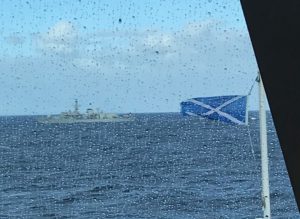
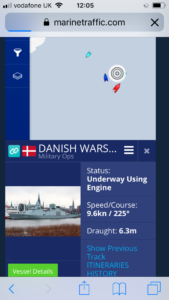 The Loch Seaforth is a new ship and takes three hours to Lewis. At first this is just like a cruise but in The Minches the sea state gets up to what the shipping forecast describes as ‘rough’. The rain comes down and the bows throw up big spray onto the observation lounge windows. Most adventurous. Sid spends a few minutes finding an AIS site to checkout the local shipping. A warship that we had assumed to be one of Her Majesty’s turns out to be Danish. The Vikings are on our side now. Doris wanders down below to the more stable area amidships.
The Loch Seaforth is a new ship and takes three hours to Lewis. At first this is just like a cruise but in The Minches the sea state gets up to what the shipping forecast describes as ‘rough’. The rain comes down and the bows throw up big spray onto the observation lounge windows. Most adventurous. Sid spends a few minutes finding an AIS site to checkout the local shipping. A warship that we had assumed to be one of Her Majesty’s turns out to be Danish. The Vikings are on our side now. Doris wanders down below to the more stable area amidships.
On arrival at Stornaway Sid and Doris are mildly delayed returning to the car by a fascination with the measures taken to prevent the ferry bonging into the pier in bad weather; and then there is a need to see the Man With String Fling His Thing, but all good things must come to an end and disembarkation beckons.
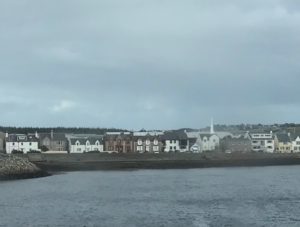
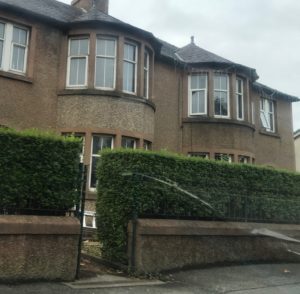 Into an surprisingly suburban-looking town, after you have got used to the single-storey houses of Orkney, and also behind a French van from the Gironde and a Spanish van. These are the first non-UK, indeed, almost the first non-Scottish plates we have seen all trip, and Bothy muses about the potential for a Hebridean tapas bar.
Into an surprisingly suburban-looking town, after you have got used to the single-storey houses of Orkney, and also behind a French van from the Gironde and a Spanish van. These are the first non-UK, indeed, almost the first non-Scottish plates we have seen all trip, and Bothy muses about the potential for a Hebridean tapas bar.
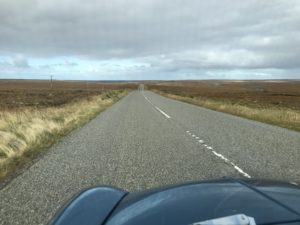 Which musing is quickly forgotten as in a few hundred yards we are out onto the moorland and on with the plan to blitz all brown signed attractions, to include a sheiling, a Black House, a Norse Mill, more Black Houses, Callanish standing stones and just one more broch. Doris has a List.
Which musing is quickly forgotten as in a few hundred yards we are out onto the moorland and on with the plan to blitz all brown signed attractions, to include a sheiling, a Black House, a Norse Mill, more Black Houses, Callanish standing stones and just one more broch. Doris has a List.


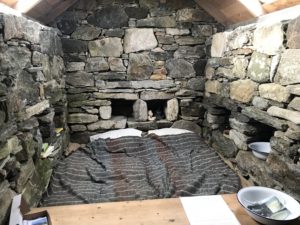 A sheiling in this instance is newly built to show, handily for the main road and the tourist traffic, what they were like when these stone built huts were used to house a shepherd away on the local squashy equivalent of Alpine summer pasture. Bigger than a glamping pod but quite hard to heat.
A sheiling in this instance is newly built to show, handily for the main road and the tourist traffic, what they were like when these stone built huts were used to house a shepherd away on the local squashy equivalent of Alpine summer pasture. Bigger than a glamping pod but quite hard to heat.
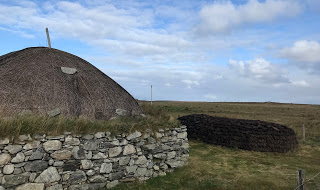
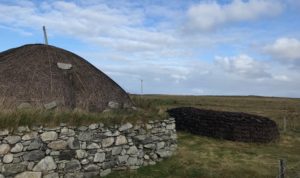 Attraction number 2 is a blackhouse. The Hebrides are blessed (?) with many of these. Your proper blockhouse had several linked rooms with the taller beasts at one end and the shorter at the other.
Attraction number 2 is a blackhouse. The Hebrides are blessed (?) with many of these. Your proper blockhouse had several linked rooms with the taller beasts at one end and the shorter at the other.
The sign says “Please Mind Your Head”
On down the road and the Norse Mill opened with a warning not to set the grass on fire with incautious use of cigarettes. Whatever the locals smoke would seem to have some impressive incendiary powers.
 Eventually over the hill and down the path we found two thatched huts by a stream. In one is a pair of grindstones but no motive power. How does it work? Doris asks. It takes Sid a while to guess there must be a side-shot wheel in the under the floor. There is a wheel underneath but no water and it takes us a while to find a leat that must have been fed from a sluice up at the nearby loch. Most satisfying. And like the sheiling, built (sorry, “reconstructed”) in these last few years.
Eventually over the hill and down the path we found two thatched huts by a stream. In one is a pair of grindstones but no motive power. How does it work? Doris asks. It takes Sid a while to guess there must be a side-shot wheel in the under the floor. There is a wheel underneath but no water and it takes us a while to find a leat that must have been fed from a sluice up at the nearby loch. Most satisfying. And like the sheiling, built (sorry, “reconstructed”) in these last few years.
 We walk back to Teal (bottom right in this picture) – from a watermill to a windmill.
We walk back to Teal (bottom right in this picture) – from a watermill to a windmill.

Onwards down the road… and on the left we see what must surely be the home of our Hebridean Tapas Bar Owner [screenshotted from Mr Google StreetMaps because I was not quick enough on the draw with the camera – it is very impressive and/or slightly scary that the StreetMappoMobile has even scanned the Outer Hebrides. D.] We imagine the conversation between Jose, his local architect and the Harris Planning Committee as his Spanish-style dream home plans are reduced to putting three arches on the front of an otherwise typical one-and-a-half storey grey/cappuchino rendered house.
Back to the past and down to the blackhouse village at Garenin. It said it was covid-closed to the public but there was activity and the gate open so we walked in. This village of maybe eight houses was abandoned in 1974 when the inhabitants found that the lure of a centrally-heated, waterproof and mains-sewerage council house was simply too tempting. Then somebody (one of Bothy’s relatives?) realised this was real heritage that people could connect with. The houses have been renovated with new thatch held down with traditional netting and stones, which gives you some indication of the winds expected during the winter. The window frames have been remade. These houses would have had cattle at one end and a family at the other. Now you can hire them for an authentic folk experience, and there is even a larger bunkhouse so you can have the pleasure of hen/stag groups next door in your wilderness too.
Meanwhile Doris had been intrigued by the fence patterns shown on the OS map, which looks like every house has an extremely long and very narrow garden. As most of the fences are post-and-wire it is difficult to see these from the road, but across the valley is an older set of walls showing the pattern in practice.

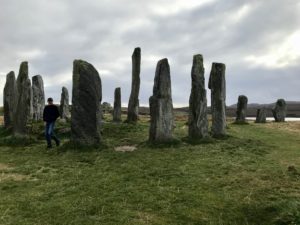 Your duo rush on hoping the island might have an open coffee shop in amongst the brochs and lochs. When we get to the Callanish stones we see some more people we’ve seen at other sites (there is a obvious circuit round the attractions) and Sid gets talking to one couple while Doris is busy taking artistic pictures of what is probably the most photographed stone in the Hebrides.
Your duo rush on hoping the island might have an open coffee shop in amongst the brochs and lochs. When we get to the Callanish stones we see some more people we’ve seen at other sites (there is a obvious circuit round the attractions) and Sid gets talking to one couple while Doris is busy taking artistic pictures of what is probably the most photographed stone in the Hebrides.
We drive on through some amazing scenery as the weather lifts and our spirits with it.
Arriving in Tarbert Sid parks up while Doris engages with the locally-born receptionst in the Harris Hotel (accent definitely Welsh but Lewis born). In the car park is a large NHS trailer for the mobile breast screening programme. Sid had originally guessed they were blood collecting and would cheerfully have given but as it turns out he has little to offer. A couple of local women just out of the trailer are keen to chat about where to walk tomorrow. So we have a recommended beach walk which they calculate will work perfectly with the tide times. The more we talk to the people the more fun we have.
